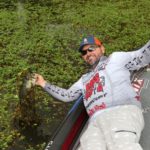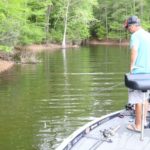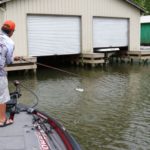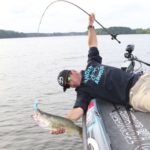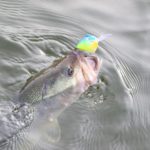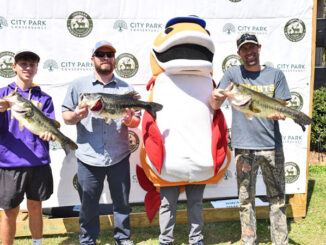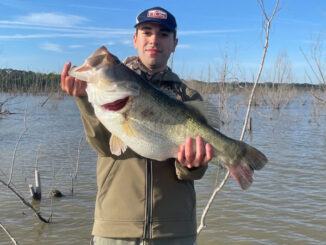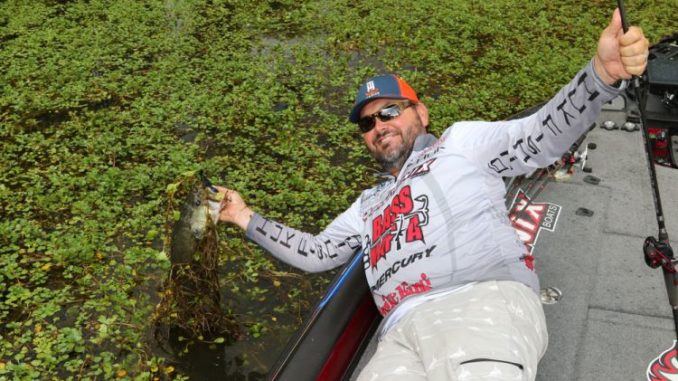
Identifying the types and sizes of pockets bass are inhabiting right now is a big key to catching fish. Here’s how a couple of Elite Series pros break it down.
Think of a scavenger hunt: You’re trying to locate a specific objective and the task requires a lot of looking. Random scrambling wastes too much time, so you try to mentally break down the search by likely parameters — where would the hunted items likely exist?
That’s essentially the premise behind “pocket hopping.” The phrase means what it sounds like it means — working from one pocket to the next; often running a similar pattern, in hopes of finding bass.
“From spring all the way through fall, pocket hopping can be phenomenal,” said Bassmaster Elite Series pro Mike Iaconelli. “The interesting thing is that, like dock fishing or running ledges, you have to figure out the particulars of what kind of pocket the fish want.
“The first thing I try to do is identify what kind of pockets are they in. Are they in big main lake pockets or are they in small side pockets? And those can be sleepers, by the way. A lot of guys ignore small side pockets. So, after I identify the types of pockets, the next thing is to put the other factors into play.”
Here are some of the main criteria:
All in the angles
For starters, consider the bank angle. Fish need different things in different times of the year, and how abruptly the bank meets the water says a lot about when it’s going to be most popular.
“In the springtime, I’m going to look for the flatter pockets; and you can do that by looking at a paper topo map or the mapping that comes standard on most GPS units,” said Elite pro Greg Hackney. “Typically, that flat, shallow water warms up quicker and gives them more places to spawn.
“You can catch them in the deeper pockets in the spring, but not as many. It seems like those flatter pockets replenish faster and there will be more fish bedding in those pockets.”
During the summer months, Hackney said the preference flips and those pockets with steeper banks start to shine. For his summertime work, Iaconelli said he likes pockets with deeper water and a dominant channel running into them. These drains, he said, provide security, comfortable water temperatures and feeding opportunities.
“A place with cover on it is a sweet spot — a spot on a spot, we call it,” Iaconelli said. “It would be like where that drain runs in the back of a pocket and touches something like an isolated brush pile, or a log; that’s the ticket.”
Hackney adds this thought: “With summertime pocket hopping, it can just be a 1- or 2-foot ditch. The deepest part of the pocket may be 3 feet, but the best part is where that 3 feet of water gets close to the cover or close to the bank. I don’t care if you spend all of your time in 6 feet or less, or 60-foot deep; there’s hardly any way to truly be efficient without electronics.”
This clearly applies to another of Iaconelli’s faves — secondary points. Tuck inside the mouth of a major creek or pocket and note where those lesser extensions occur. Natural gathering spots for forage and therefore natural feeding spots for predators, secondary points offer that ideal blend of shallow strategy with quick access to deeper water.
The big cover up
Hackney’s biggest summertime requirement is a pocket with cover. That might be bank grass with floating vegetation matted nicely, docks or overhanging trees.
“I’m going to be looking for some place that whenever that sun is beating straight down, that fish has a place to hide,” Hackney said. “Typically, once the weather gets warm, I’m going to stay away from clean pockets without cover. With that being said, if you have a clean pocket that has one good piece of cover on it, chances are it will have a bass on it.
“It’s not necessarily that I would be against fishing shallow pockets in the summertime, but they just have to have that piece of overhang. It can be a leaning tree; something that allows that fish to suspend in the shade some time during the day.”
Similarly, Iaconelli likes finding pockets with brush in the back. The rest of the area may be lackluster, but a little cover in the right place will draw fish with magnetic force.
“You hit three pockets, you get one bite and it’s in the only pocket with brush in the back; they’re the kind of pockets I’m going to target,” he said. “I’m going to let the fish tell me what they want.”
And don’t overlook water clarity as a form of concealment — or lack thereof. Iaconelli said he’s had tournaments where he could only catch fish in clear-water pockets, while other times found only stained areas productive.
Food for thought
Possibly the most important detail for pocket hopping is food. With the exception of the spawn, bass will always want to have a food source readily available, so pay close attention to the meal options.
Shad schools play a big role here and savvy anglers will monitor their side-imaging sonar when advancing into a pocket. Spot a wad of baitfish holding on a channel turn or a little drop, and you can bet they won’t go unnoticed.
“I love pockets that have wind blowing into them and, sometimes that alone is the criteria for which ones I fish,” Iaconelli said. “If I have my choice, I want the pockets with wind blowing into them, because that blows bait into them and the fish are easier to catch in cleaner water.”
The other one is seasonal, but it’s a straight-up bass magnet — bream beds. When panfish — bluegill and others — start making little ones, they tend to cluster their nests in close proximity. This creates an irresistible feeding opportunity for opportunistic bass, which roam the banks and pick off distracted panfish.
In clear water, a bunch of bream beds often take on a honeycomb pattern. Keep watch for boils and wakes in the shallows and a hungry bass might give up his location — and that of his buds.
Bait selection
For those bream bed fish, a topwater bait is one of your best options. Walkers will earn some attention, but since the strike zone is often pretty tight, you may not have a lot of space for an effective cadence. You’ll do better here with poppers and prop baits which don’t need a lot of space to make a lot of commotion.
The old reliable wacky-rigged stick worm’s another option, but mostly as a follow-up. If you can get that topwater bite, the adrenalin rush is worth the effort.
For general pocket work, Iaconelli leads with crankbaits. Especially when he’s covering water to find fish, he’s a fan of the Rapala DT10, DT14 and DT20, depending on depth.
“Once I locate the sweet spot, I’ll be in the middle of that drain, and I’ll quarter cast as I’m going down that drain,” Iaconelli said. “They tell you, pretty quickly, if you’re on the right spot. You hook one and there’s often more behind it, so you hit Spot-Lock, drop a marker buoy or whatever you want to do.
“I’ll continue to catch them, but I’ll always have a follow-up bait and one of my favorites is an old-school Carolina rig with a Berkley Power Lizard or Berkley Power Worm. It’s a great clean-up bait.”
Hackney says his No. 1 pocket-hopping bait is a Strike King KVD Sexy Frog (no pun intended), but he’s also going to keep a KVD 1.5 squarebill and a Strike King Thunder Cricket bladed jig handy. Swimming a Hack Attack swim jig also delivers this time of year, as does flipping a Strike King Shimmy Stick with a light sinker.
Whatever your bait of choice, know that pocket hopping holds the potential for big-time summer success. The fish are waiting, so … hop to it. (Sorry, couldn’t resist.)
